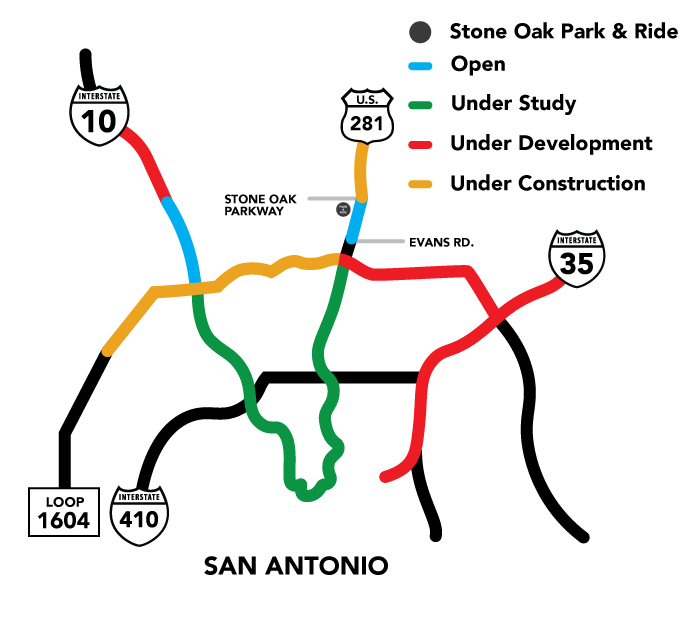FAQs
What is an HOV lane?
HOV stands for High Occupancy Vehicle. An HOV lane is a special lane reserved for those carrying more than one person, such as carpools, vanpools and buses. They are usually located next to the regular, or unrestricted lanes. These special lanes enable those who carpool or ride the bus an added advantage of bypassing the traffic in the adjacent, unrestricted (“general purpose”) lanes. Lanes are identified as “2+” which refers to the minimum number of occupants to qualify.
How do they work?
HOV lanes are intended to incentivize throughput (the movement of more persons per vehicle, per lane) and save time for carpoolers and bus riders by enabling them to bypass the areas of heaviest traffic congestion. Because most drivers, especially during rush hours, are driving alone, the HOV lane is seldom congested. Giving carpoolers a reliable and congestion-free ride during rush hour serves as a strong incentive for ridesharing. HOV lanes also provide commuters a needed alternative to congestion.
Do HOV lanes in Bexar County cost anything to use?
No, all HOVs in the county are free to use 24 hours a day, seven days a week as long as your vehicle meets the HOV requirements.
I drive alone to work. How will I benefit from HOV lanes?
HOV lanes benefit not only those who share the ride, but all drivers, taxpayers and area residents. First, by encouraging
high-occupancy travel (that is, more passengers in fewer vehicles) these lanes can help ease congestion in heavily traveled metropolitan areas. Second, by reducing the traffic burden on highways, they can help defer costly expansion projects. Third, by reducing the number of vehicles on the road, HOV lanes can help reduce the extent of exhaust emissions and contribute to cleaner air.
How does the VIA Vanpool program work?
Through the VIAWorks Vanpool program, commuters in groups of 5 to 15 share a ride to work using a van provided by VIA. The participants split the cost of the van rental and fuel. Vanpools can be sponsored by your employer or setup by VIA.
More on the Vanpool program.
Where would I find out about ridesharing opportunities in my area?
Alamo Commutes provides free carpool matching, rewards, and an Emergency Ride Home for smart transportation users through their website and mobile app.
What does an HOV lane look like?
For the most part, HOV lanes look like any other highway lane, except that it is delineated with signs and diamonds painted on the pavement. The lanes are located on the inside left of the highway. A dotted white line will indicate that it is permissible to change lanes and enter into the HOV lane.
Who is responsible for building and operating HOV lanes?
In Bexar County, the Texas Department of Transportation builds the HOV lanes and VIA Metropolitan Transit manages them.
How are HOV lanes enforced?
All HOV projects rely on state or local police officers to monitor and enforce HOV lane requirements. All HOV lanes in Bexar County will be monitored by the San Antonio Police Department.
What happens to drivers who violate HOV lane rules?
Violators may be stopped and cited by the San Antonio Police Department or be simply re-directed back into the slower-moving general purpose lanes.
Do children and infants count as passengers?
Yes. All states with HOV facilities count children and infants count as passengers.
Why do HOV lanes sometimes appear empty?
HOV lanes, designed to be free of congestion, sometimes have the appearance of being lightly traveled, especially when compared with adjacent, congested unrestricted lanes. When total person throughput (the number of people traveling) is compared, HOV lanes are typically more efficient than unrestricted lanes. This is because HOV lanes carry more people than unrestricted lanes, making them highly efficient as well as beneficial to air quality.
Why are motorcycles allowed in some HOV lanes?
Motorcycles are permitted by federal law to use HOV lanes, even with only one passenger. The rationale behind allowing motorcycles to use HOV lanes is that it is safer to keep two-wheeled vehicles moving than to have them travel in start-and-stop traffic conditions.
What is the safety record of HOV lanes?
HOV lanes have existed nationally for almost four decades now. Studies have shown that HOV lanes are frequently as safe as, and in many cases safer than, unrestricted lanes.
Do HOV lanes operate only during rush hours?
Operating hours for HOV lanes in Bexar County are 24 hours a day, seven days a week.
Are HOV lanes effective?
Yes, though results vary from state to state. Nearly every state with HOV lanes reports that ridesharing and overall corridor person moving efficiency has increased since the lanes opened.
Can the operational rules of the HOV Lanes change over time?
Yes, TxDOT and VIA will be continuously monitoring the operation of the HOV lanes. Operational rules can change over time in order to maintain good traffic flow and safety. This could include changes to the time of day, occupancy requirements, and/or entry/exit locations.
